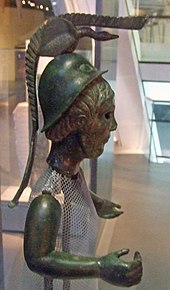Brigantia (goddess)

Brigantia or Brigindo
Through
Etymology
The name is derived from Proto-Celtic *brigantī and means "The High One", cognate with the
Evidence for Brigantia
This goddess appears in several locations across the Celtic world, sometimes likened to Brigindo in Gaul or Brigit in Ireland or Great Britain.[5]
Inscriptions

Currently, there are eight known inscriptions to Brigantia in Britain., is an inscription:
- Brigantiae s(acrum) Amandus / arc(h)itectus ex imperio imp(eratum) (fecit)[7]
Two inscriptions associate Brigantia with the Roman goddess Victoria, one from
- D(eae) Vict(oriae) Brig(antiae) / et num(inibus) Aauugg(ustorum) / T(itus) Aur(elius) Aurelian/us d(onum) d(edit) pro se / et suis s(e) mag(istro) s(acrorum) // Antonin[o] / III et Geta [II] / co(n)ss(ulibus)
In Adel, an altar was found before 1816 with the inscription Deae Brigantiae Donum Cinge/ Tissa Posuit.[10]
At
- Iovi aeterno / Dolicheno / et caelesti / Brigantiae / et Saluti / C(aius) Iulius Ap/ol(l)inaris / |(centurio) leg(ionis) VI iuss(u) dei
There is an inscription at Irthington near Brampton in Cumbria DEAE NYMPHAE BRIGANTIAE—"to the divine nymph Brigantia".[12]
There are two inscriptions referring to Dia Brigantiae (the goddess Brigantiae).[13]
There is one inscription to "Tutela Brigantia Augusta".[14]
Garret Olmstead noted numismatic legends in
Iconography
At
Toponymy
There are several placenames deriving from 'Brigantium', the neuter form of the same adjective of which the feminine became the name of the goddess. Association of these with the goddess is however dubious, since the placenames are easily explained as referring to a "high fort" or "high place" in the literal sense.
Lisa Bitel noted a wide spread through toponymy:
The town of
Brigit.[18]
Other towns which may also preserve this theonym include
The ancient name of
References
- ^ "Déesse du Menez-Hom". www.collections.musee-bretagne.fr (in French). Retrieved 3 February 2021.
- )
- ^ Matasović, Ranko (2009). Etymological Dictionary of Proto-Celtic. Leiden Indo-European Etymological Dictionary Series. Vol. 9. Brill. pp. 78–79.
- ^ Mallory, J. P.; Adams, Douglas Q., eds. (1997). Encyclopedia of Indo-European Culture. Taylor & Francis. p. 269.
- JSTOR 23660263.
- ^ Epigraphik-Datenbank Clauss/Slaby.
- ^ RIB 2091.
- ^ AE 1892, 00098; RIB 628
- ^ RIB 627.
- ^ "RIB 630. Altar dedicated to Brigantia | Roman Inscriptions of Britain".
- ^ AE 1947, 00122; RIB 1131.
- ^ CIL VII, 00875, Nicholson.
- ^ McGarth, Sheena. Brigantia: Goddess of the North, 2015
- ^ McGarth, Sheena. Brigantia: Goddess of the North, 2015
- ^ Olmstead (1994), pp. 354–361.
- ^ Wolf (2021), p. 141.
- ^ Green (1996), p. 197.
- ^ Bitel (2001).
- ^ Green (1986), p. 161.
- ^ CIL XII, 00095
- ^ CIL XII, 00118
- ^ AE 1913, 00014.
- ^ CIL XII, 00057.
Bibliography
- Année Epigraphique (AE), yearly volumes.
- Bitel, Lisa M. (2001). "St. Brigit of Ireland: From Virgin Saint to Fertility Goddess"". Archived from the original on 17 February 2006.
- Claus, Manfred; Epigraphik-Datenbank Clauss / Slaby, Johann Wolfgang Goethe-Universität Frankfurt. Online epigraphic search tool
- Ellis, Peter Berresford (1994). Dictionary of Celtic Mythology. Oxford Paperback Reference. Oxford University Press. ISBN 0-19-508961-8.
- Green, Miranda (1986). The Gods of the Celts. Stroud: Sutton Publishing. ISBN 0-7509-1581-1.
- Green, Miranda (1996). Celtic Goddesses: Warriors, Virgins, and Mothers. New York. pp. 195–202. ISBN 9780807614051.)
{{cite book}}: CS1 maint: location missing publisher (link - MacKillop, James (1998). Dictionary of Celtic Mythology. Oxford: Oxford University Press. ISBN 0-19-280120-1.
- Olmstead, Garret (1994). The Gods of the Celts and Indo-Europeans. Budapest. pp. 354–361.
{{cite book}}: CS1 maint: location missing publisher (link) - Roman Inscriptions of Britain (RIB).
- Wolf, Ismael (2021). "Brigantia from Birrens: cultural interactions in frontier zone of Roman Britain". Mare Nostrum. 12 (1): 139–168. S2CID 233641510.
- Wood, Juliette (2002), The Celts: Life, Myth, and Art, Thorsons, ISBN 0-00-764059-5
See also
- Brigantes, Celtic tribe associated with Northern England
- Isurium Brigantum
- Breton language
- Breton people
External links
 Media related to Brigantia (goddess) at Wikimedia Commons
Media related to Brigantia (goddess) at Wikimedia Commons- Brighid: What Do We Really Know? by Francine Nicholson includes a section on Brigantia and a picture of the Birrens bas-relief.


